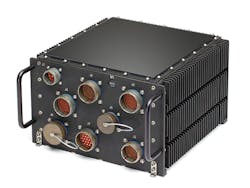Northrop Grumman will upgrade the mission computers aboard U.S. Marine Corps helicopters
CHINA LAKE NAVAL AIR WEAPONS STATION, Calif. — Avionics and flight computer experts at Northrop Grumman Corp. will upgrade VME-based FlightPro Gen III scalable mission computers aboard the U.S. Marine Corps AH-1Z Viper attack helicopters and UH-1Y Venom utility helicopters.
Officials of the U.S. Naval Air Warfare Center Weapons Division at China Lake Naval Air Weapons Station, Calif., have announced an $89 million contract increase to the Northrop Grumman Mission Systems segment in Woodland Hills, Calif., to upgrade existing mission computers on Viper and Venom helicopters.
Northrop Grumman is upgrading mission computers aboard U.S. Marine Corps AH-1Z Viper attack helicopters and UH-1Y Venom utility helicopters.
The contract increase involves research and development of AH-1Z and UH-1Y system configurations for Viper and Venom mission computers. Northrop Grumman engineers will upgrade existing mission computer software and hardware for improved performance, as well as to mitigate obsolescence issues.
The company also will handle block upgrades to the integrated avionics systems aboard the AH-1Z and UH-1Y helicopters, including prototypes, simulations, and weapons models. Northrop Grumman engineers also will look into future avionics improvements.
The Northrop Grumman Gen III mission computers are the heart of the integrated avionics system that powers the glass cockpit avionics of the UH-1Y and AH-1Z helicopters.
The conduction-cooled Gen III mission computer has a ruggedized 6U VME PowerPC-based single board computer. Interfaces include Fast Ethernet, four serial ports, parallel I/O, and built-in-test. FlightPro has a standard partitioned real-time operating system called INTEGRITY-178 tuMP for multicore architectures from Green Hills Software in Santa Barbara, Calif., with ARINC 653 and POSIX support.
The mission computer’s standard configuration also includes a quadchannel 1553 mezzanine card, high-speed serial card, digital I/O module with eight channels of opto-coupled discrete inputs, eight channels of opto-coupled discrete outputs, and 16 channels of general-purpose bi-directional discretes that can be programmed individually as embedded computing outputs or inputs.
The flight computers use 28-volt DC or 115-volt AC three-phase 400 Hz input power, measure 13.61 by 11.5 by 7.55 inches, and weigh 30.4 pounds. The computers have rated 3,200 hours mean time between failures.
The flight computer software is RTCA DO-178C compliant, has ARINC-653 partitioning for safety and security, and complies with the Modular Open Systems Architecture (MOSA) standard. The software is aligned with the Future Airborne Capability Environment (FACE) technical standard, has hardware-independent application software developed to MIL-STD-498, under MIL-STD-882C safety program environmental qualification.
Flight computer hardware is designed to MIL-STD-461D for electro-magnetic compatibility, and is tested to MIL-STD-462 and MIL-STD 810E. FlightPro is conduction cooled, and represents “Quiet Cockpit Technology,” Northrop Grumman officials say.
Dual mission computers are part of Northrop Grumman’s integrated avionics aboard the AH-1Z and UH-1Y. The mission computers provide centralized control of the helicopter avionics, displays, situational awareness, and health monitoring.
Additionally, the helicopter avionics and mission computers can accommodate future system upgrades; rapid insertion of new technologies; and integration of other avionics, communications, and survivability equipment. Northrop Grumman also provides the operational flight program software.
The H-1 Upgrade program is replacing aging AH-1W and UH-1N helicopters with upgraded UH-1Y and AH-1Z aircraft to enhance commonality, reliability, and maintainability.
For more information contact Northrop Grumman Mission Systems online at www.northropgrumman.com, or the Naval Air Warfare Center Weapons Division-China Lake at www.navair.navy.mil/nawcwd/command/Navy.aspx.

